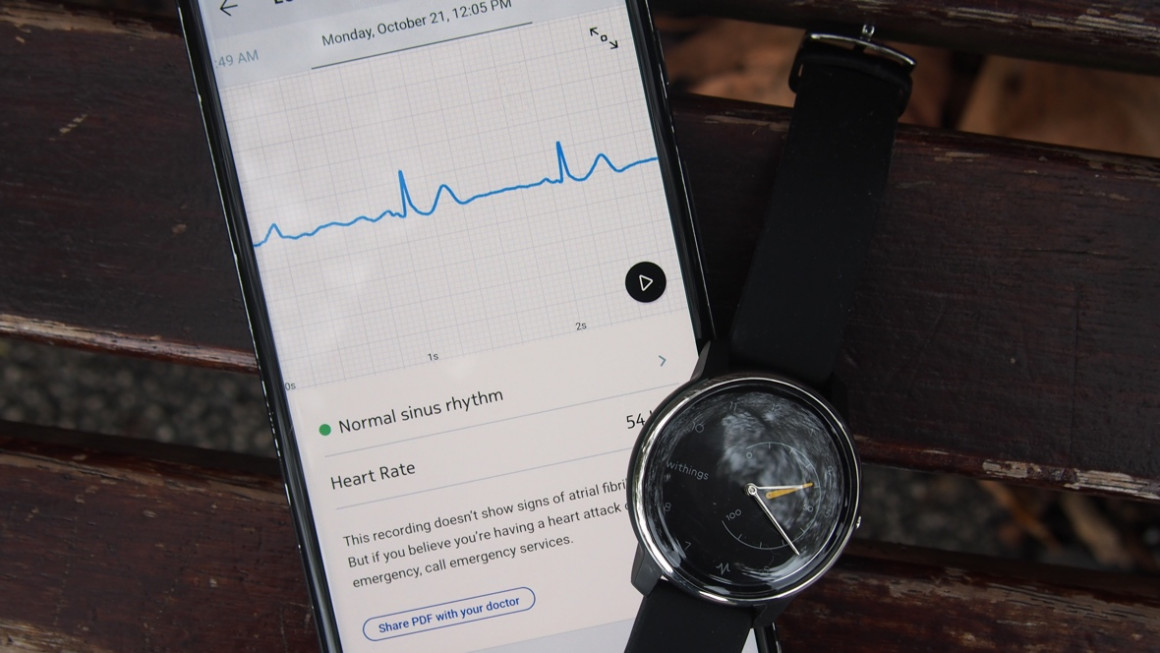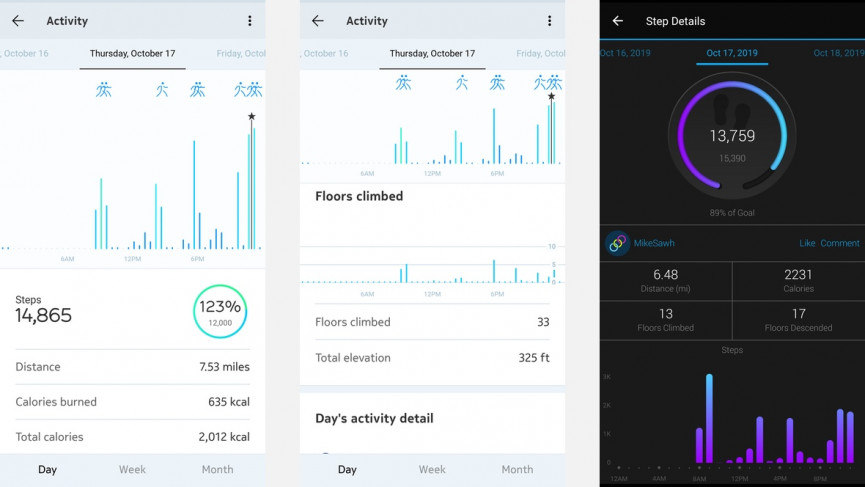
- Small, elegant design
- ECG support
- Discreet fitness tracking
- Screen prone to easily scuffing
- Basic data for automatic tracking
- Questionable elevation data
The Withings Move ECG is the first hybrid smartwatch that lets you take clinical-grade heart rate readings from the wrist. In doing that, Withings claims it can detect atrial fibrillation.
It does of course join the Apple Watch Series 5 in offering that potentially life-saving feature. Unlike Apple's smartwatch, Withings doesn't have FDA approval for its built-in electrocardiogram feature in the US, but it has been clinically validated in Europe.
It's important to note that the Move ECG now been bested (in terms of features) by the Withings ScanWatch, which also boasts ECG and an SpO2 sensor that the company claims can detect sleep apnea.
Along with its more serious health monitoring skills, it's very much a Withings watch at heart, offering a way to monitor your step counts from the watch face. It can also automatically track activities like running and swimming, and you can also piggyback off your phone's GPS to map outdoor workouts.
At just it's also pretty wallet-friendly, especially in comparison to the limited ECG wearables competition.
We've been putting the Move ECG to the test for over a month to find out how a big a deal that health tracking feature is and whether Withings has delivered us another slick hybrid. Here's our full verdict.
Withings Move ECG: Design

Prior to launching the Move ECG, Withings launched the Move, a hybrid offering fitness tracking features and a host of customization options.
After a brief stint in Nokia's ownership, Withings marked its return with the Steel HR Sport. While we were fans of the feature-packed hybrid, it did lose that traditional watch feel we have come to associate with Withings' watches in order to make it better suited for a sweaty workout.
Read this: Best smartwatches to buy now
The Move ECG carries a lot of the same design hallmarks as the cheaper Move and feels very much like a hark back to the Withings of old.
It measures in with a 38mm case accompanied by an 18mm silicone watch band. You've got your pick of white or a black watch face with a host of optional bands up for grabs too.

Compared to the Steel HR Sport, the Move ECG sits more elegantly on the wrist and feels more like a dumb traditional watch. Our review model had the black watch face with a black band, and most people who spotted it had not idea it was "smart".
No doubt we'd like it to be a touch slimmer than its 13mm thick frame, but it's not something we think a lot of people will be bothered about. It's just us a being a little picky.
The defining features lie in the analog-style watch hands and face, along with the sub-dial that displays your step count. There's no digital screen here because there isn't any other data it can really show. The Move ECG doesn't offer notification support. It's all about health and fitness.
But (and it's a big but) there is a problem with that domed glass display. It was very easy to scuff as you might notice from our pictures. What looks like a fingerprint mark we've lazily left in shot is actually a scratch. So you'll need to be careful.
On the waterproofing front, it's been slapped with a 5ATM water resistant rating, which means you can take it in the water and go swimming with it too.
Withings Move ECG: Taking an ECG reading

The headline feature here is of course the ECG (or electrocardiogram) that gives you insight into how your heart is ticking.
Essential reading: Atrial fibrillation explained
Unlike the optical heart rate sensors you find on most wrist-worn wearables, the ECG method takes an electrical heart rate reading and is a method traditionally used in a hospital where electrodes are placed on the skin.
With the Move ECG, that process is replicated but is achieved in a more non-invasive way. It currently has a CE marking for medical devices, which means it's suitable to generate those serious health insights for users in Europe.
Withings aims to offer users the ability to diagnose heart issues like arrhythmias, one of which is atrial fibrillation (or AFib). This is an anomaly of the heart’s electrical activity.
Atrial fibrillation and an irregular heartbeat can lead to the build up of blood in the atria (upper chambers of the heart), forming blood clots that could increase the chances of a stroke. It can also overwork the heart muscle and lead to heart failure.
To make those ECG measurements possible, Withings places two electrodes on the back of the watch case and another on the metallic ring bezel that sits around the watch face.

To take a measurement, you'll need to press the side button once and then place your fingers on the bezel. A reading takes 30 seconds and, handily, the yellow hand on the sub-dial will count down until the reading has been completed.
For that first ECG reading, you'll need your phone near by, but it's just so Withings can walk you through how it works. You'll be prompted to do as instructed above and you'll need to keep still while the reading is taken. During that time, you can see a reading happening on the ECG graph in real time in the app before it's saved and stored.
Saved readings are displayed in the Timeline section of the app, where you'll get an indication of whether you have a normal heart rate rhythm. You can also dig deeper to replay individual readings and get an explanation of what it means.
There is also the option to share the data as a PDF file with your doctor. If you don't have an abnormal reading, it will say that, but does also state that if you are having a heart attack or a medical emergency you should contact emergency services.
We decided to compare the ECG measurement results on the Move ECG with the same feature on the Apple Watch Series 5. What we found was that the measurements were not identical, but they did come to the same conclusion that we did not show signs of irregularities.
Currently, Withings says it can only detect atrial fibrillation, but can also record heart rate rhythm related to other heart issues that it says require follow-up tests. That includes heart failure and valvular heart diseases.
So right now you're just restricted to one form diagnosis. We say "just" but like the Apple Watch, what Withings has managed to achieve should be regarded as another major breakthrough wearables, making a potentially life-saving technology available in a smartwatch that costs .
Withings Move ECG: Fitness tracking

Away from monitoring your heart, the Move ECG does also have other skills. It won't nudge you about notifications or let you control music from your phone. It does offer 24/7 activity tracking including automatic sleep monitoring and the ability to measure elevation thanks to the onboard altimeter.
Discreetly tracking your steps and putting your progress on show on the watch face has been a staple feature of Withings' watches. That yellow hand will let you know how far or close you are to your daily goal, which you can adjust in the Withings Health Mate app.

Step tracking compared: Withins Move ECG (left and centre) and Garmin Fenix 6 (right)
To test accuracy, we put the Withings Move ECG up against the Garmin Fenix 6 Pro. Above is a sample of our daily step counts. The differences between those overall step totals pretty much represent the results on most days.
They were never matched, but they were never wildly apart. It was a similar story for calorie burn data, though there was a bigger difference between the floors climbed with the Move ECG usually reporting more floors climbed on a daily basis.
There's nothing in the way of motivational features to keep you moving like inactivity prompts or adaptive step goals based on your previous step totals. One nice touch inside of the app is your 'Days activity detail', which lets you see all of your exercise chronologically. Ultimately though, it's no-frills fitness tracking, which might be fine for most but may leave others wanting more.
The Move ECG does also offer automatic sleep monitoring too, providing details on sleep duration, time in bed and a breakdown of sleep to awake, light and deep sleep. We put it up against the Garmin again as well as Withings' dedicated Sleep monitor, which sits beneath your mattress.

Sleep tracking compared: Withings Move ECG (left), Withings Sleep (middle) and Garmin Fenix 6 (right)
Above is sample data from one night's sleep using those three devices. What it shows is that the two Withings devices are not far off each other as far as recording sleep duration, but the Move ECG offers far more basic data.
The Garmin recorded a longer sleep period, generally picking up sleep time over an hour earlier. We've come to rely on the reliability of the Withings Sleep monitor as opposed to another wrist-worn tracker, so we'd say the Move ECG has done a good job here.
Withings Move ECG: Sports tracking

To look at it, you wouldn't expect the Move ECG to do more than its headline feature and those fitness tracking basics. But it has a few other tricks.
There's automatic exercise recognition with the ability to detect more than 30 activities. If you want to go running or cycling with it, you can lean on your phone's GPS signal to get mapped routes. All in all, it does a fair amount for a hybrid that costs less than .
To manually track a workout you'll need to hold down the button on the watch and check in on the app to ensure it's started tracking. When it comes to the automatic tracking, you simply need to do your thing and hope the Move ECG works it out, and uses its accelerometer motion sensor to correctly track the distance.

We tried it with a range of activities including a run, a indoor rowing workout and a swim. With the run, it had accurately recognised the duration of the run, though the distance recorded fell short of the actual distance run.
With the indoor rowing session, again, it accurately registered the duration but actual workout data is nonexistent. For the swim, it was much the same as the run. It got the workout duration right, but offered calorie burn data and nothing else.
If you were hoping that the Move ECG was a supercharged sports watch in an analog watch body, you're going to feel slightly let down with what you actually get. The connected GPS support is nice to have certainly, though it would be nice to have more metrics with the automatic exercise tracking.
Withings Move ECG: Battery life
There isn't a great deal we can say about battery life because the Move ECG doesn't need charging. It runs on a CR2430 button cell battery, the same kind you'll find powering a lot of traditional watches.
That battery should be good enough for year's worth of tracking before you need to head to your nearest watch shop and get it replaced.
How we test
